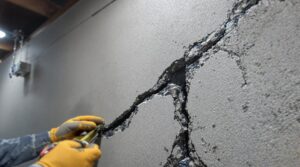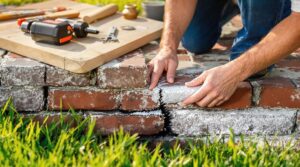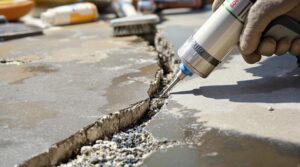Homeowners can pay for foundation repair through various financial options. Homeowners insurance may cover damage from specific perils. Payment plans with repair companies, home equity loans, and personal loans can also provide necessary funding. Government-sponsored financing options and cash-out refinancing may be viable alternatives. Utilizing emergency savings is another possibility. By understanding these financing methods, homeowners can make informed decisions about managing foundation repair costs and explore potential solutions in more detail.
Key Takeaways
- Homeowners can file an insurance claim if their policy covers foundation damage caused by specific perils like fire or storms.
- Public adjusters can help assess damage, review insurance policy coverage, and gather documentation to support claims and maximize benefits.
- Payment plans with repair companies, home equity loans, and personal loans are financing options available for homeowners to cover foundation repair costs.
- Government-sponsored financing options like USDA and HUD loans offer favorable terms, including lower interest rates and flexible repayment options, for low-income homeowners.
- Using emergency savings or cash-out refinancing can also help cover repair costs, but homeowners should evaluate long-term financial benefits and consider potential risks.
Investigating Homeowners Insurance Coverage
When investigating homeowners insurance coverage for foundation repair, it is essential to understand the policy's inclusions and exclusions. Coverage typically extends to damage caused by covered perils, such as fire or storms, but excludes wear and tear or neglect.
Homeowners should also familiarize themselves with the claims filing process, which may require submission of documentation and proof of the cause of damage.
Policy limits and deductibles can greatly impact out-of-pocket costs for repairs, making a thorough review of policy terms and conditions vital. Understanding replacement cost coverage can affect how much compensation you receive for foundation repairs.
Coverage Inclusions & Exclusions
Although homeowners insurance can provide financial relief for foundation repair costs, the extent of coverage depends on the specific policy terms and the cause of the damage.
Homeowners insurance policies typically cover damage caused by covered events, such as fires or storms. However, standard policies often exclude damage resulting from poor maintenance, settling, or soil erosion.
Additional policies or endorsments may be required for coverage of natural disasters like earthquakes or floods.
To understand coverage inclusions and excluded coverage, it is essential for homeowners to review their policy details and consult their provider.
By clarifying policy terms, homeowners can determine the extent of financial reimbursement for foundation repair costs and make informed decisions regarding their coverage needs.
Consultation can also help identify potential coverage gaps.
Only 27% of homeowners in designated flood zones maintain flood insurance, highlighting the importance of understanding and securing appropriate coverage for foundation-related water damage.
Claims Filing Process
Homeowners must review their policy to identify coverage for foundation damage, then notify their insurance provider to begin the claims process.
The provider requires documentation of the damage, including detailed photographs and repair estimates, to support the claim.
Homeowners should verify that the damage is caused by a covered event, such as a fire or storm, as most policies exclude natural wear and tear.
A deductible may apply before insurance coverage takes effect, impacting the overall cost of repairs.
Upon approval, understanding the claims process and timeframes can help homeowners manage expectations and expedite foundation damage repairs.
Effective communication between homeowners and insurance adjusters can significantly improve the likelihood of a successful claim resolution.
Policy Limits & Deductibles
Investigating homeowners insurance coverage for foundation repair necessitates a thorough examination of policy limits and deductibles.
Homeowners insurance typically covers foundation repair costs only if the damage is due to a covered event such as fire, storm, or vandalism. Most policies require the homeowner to pay a deductible, which can range from a few hundred to several thousand dollars, before the insurance coverage kicks in.
Coverage limits vary considerably between policies, with some providing only minimal coverage for structural damage. It is essential to review specific policy details and clarify coverage limits and exclusions related to foundation repair with the insurance provider.
This guarantees a clear understanding of financial responsibilities regarding policy limits and deductibles for foundation damage.
Public insurance adjusters can help maximize settlement amounts for covered foundation damage claims and ensure proper documentation.
Always Conslut With A Public Insurance Claims Adjuster First

Consulting with a public insurance claims adjuster is an essential step in determining the extent of coverage for foundation repair costs under a homeowners insurance policy.
A public adjuster can help evaluate the scope of coverage, assess the impact of deductibles, and identify eligible claims, ultimately maximizing policy benefits.
Studies show that working with public adjuster settlements can result in significantly higher payouts, with some claims seeing increases of up to 500% compared to handling the process alone.
Public Adjusters Help Evaluate Coverage Scope
When evaluating the extent of foundation damage and potential insurance coverage, it is vital to seek the expertise of a public insurance claims adjuster. Public adjusters play an essential role in helping homeowners navigate the complex process of insurance claims. They assess the damage, review policy coverage, and guarantee that homeowners receive fair compensation.
Key aspects of evaluating coverage scope include:
- Policy Review: Carefully examining the insurance policy to determine the extent of coverage for foundation damage.
- Damage Assessment: Evaluating the severity of foundation damage to determine the necessary repairs.
- Documentation: Gathering evidence, such as photographs and repair estimates, to support the insurance claim.
- Coverage Maximization: Making sure that homeowners receive the maximum benefits available under their policy.
Public Adjusters Help Assess Deductible Impact
The financial complexities of foundation repair can be alleviated with the expertise of a public insurance claims adjuster, particularly when evaluating the impact of deductibles on insurance claims.
Public adjusters can help homeowners determine the extent of their financial responsibility by analyzing insurance deductibles in the context of foundation repair costs. Their assessment enables homeowners to better understand the financial implications of filing a claim, which informs decisions about financing options.
Consulting with a public adjuster guarantees that homeowners comprehend policy coverage and potential exclusions affecting their claims. This expertise empowers homeowners to make informed choices about managing foundation repair expenses and selecting suitable financing options.
Effective deductible management is therefore assured through public adjusters' professional guidance.
Public Adjusters Help Identify Eligible Claims
Engaging a public insurance claims adjuster at the outset of the claims process enables homeowners to leverage expert knowledge in identifying eligible claims for foundation repair.
Public adjusters can help assess damages, document relevant information, and guarantee all necessary forms are accurately completed. This expertise can greatly enhance the likelihood of receiving a fair settlement for foundation repairs.
Some key benefits of utilizing public adjusters for identifying eligible claims include:
- Thorough Assessment: Public adjusters accurately identify and document foundation damage to support insurance claims.
- Expert Policy Knowledge: Public adjusters understand policy terms, guaranteeing that claims align with coverage requirements.
- Accurate Filing: Public adjusters ensure all necessary forms are correctly completed and submitted on time.
- Improved Settlements: By accurately identifying eligible claims, public adjusters help maximize potential payouts for foundation repairs.
Public Adjusters Help Mazimize Policy Benefits & Increase Settlement Amounts
By leveraging their vast expertise in insurance claims, public adjusters can greatly enhance the potential benefits for policyholders, thereby maximizing policy benefits and increasing settlement amounts.
As licensed professionals, public adjusters thoroughly assess damages and negotiate with insurance companies to guarantee homeowners receive fair compensation. On average, hiring a public adjuster can increase settlement amounts by 20-50%, making them a valuable asset in maneuvering complex claims.
Working on a contingency fee basis, public adjusters' interests align with policyholders', resulting in more extensive documentation of damage. This expertise also helps homeowners understand policy coverage limitations, potentially preventing costly mistakes.
To optimize payment plans and settlement amounts, it is crucial to consult with a public insurance claims adjuster first.
Exploring Payment Plans With Repair Companies

When faced with the costly prospect of foundation repair, homeowners can find relief in payment plans offered by repair companies, which can break down the financial burden into manageable monthly installments.
Many foundation repair companies provide financing options that allow homeowners to make equal monthly payments over a specified period. These payment plans may require an initial down payment, with subsequent payments scheduled based on the scope of the repair project and the total cost involved.
Key considerations for homeowners exploring payment plans with repair companies include:
- Interest Rates: Understanding the interest rates associated with the payment plan to guarantee it remains affordable.
- Total Cost: Calculating the total cost of the repair, including all payments and potential fees.
- Payment Schedules: Reviewing the payment schedule to guarantee it aligns with the homeowner's financial situation.
- Hidden Fees: Identifying any potential hidden fees or charges associated with the payment plan.
Utilizing Home Equity Loans For Repair Costs

Homeowners who do not wish to utilize payment plans offered by foundation repair companies or are in need of more substantial funding may consider alternative financing options. One viable option is utilizing home equity loans for repair costs. Home equity loans allow homeowners to borrow against the equity built up in their property, providing access to funds at typically lower interest rates compared to personal loans.
| Home Equity Loan Features | Description |
|---|---|
| Interest Rates | Fixed interest rates, ensuring predictable monthly payments |
| Equity Requirement | At least 20% equity in the home required to qualify |
| Payout Structure | Lump sum payout, with potential closing costs and fees |
| Financial Benefits | Lower interest rates compared to personal loans, making it easier to manage larger repair costs |
Considering Personal Loans For Funding

How can individuals faced with foundation repair costs obtain immediate financial assistance? Personal loans can provide quick funding for foundation repairs, with approval often available within a week.
However, borrowers must carefully evaluate their options to guarantee affordability, as interest rates for personal loans are typically higher than those for home equity loans.
The following factors should be considered when evaluating personal loans for foundation repair:
- Interest rates: Higher interest rates can greatly impact the overall cost of the loan.
- Borrowers' credit score: Approval and interest rates may depend on the borrower's credit score and income stability.
- Loan amounts: Borrowers must guarantee they borrow enough to cover the total cost of the foundation repair and any additional expenses.
- Lender options: Many banks, credit unions, and online lenders offer personal loans, allowing borrowers to compare rates and terms to find the most favorable option for their financial situation.
Leveraging Credit Cards For Foundation Repairs

Tapping into available credit, credit cards can provide an immediate financial lifeline for urgent foundation repairs, offering a convenient solution for unexpected expenses. With promotional 0% interest rates for an introductory period, homeowners can finance repairs without accruing interest if the balance is paid off before the promotional period ends.
| Credit Card Features | Benefits | Considerations |
|---|---|---|
| Promotional 0% interest rates | No interest accrues during introductory period | Higher interest rates after promotional period |
| Credit limit increase | Guarantees sufficient available credit for repair costs | May require credit score review |
| Convenient access to funds | Immediate financial lifeline for urgent repairs | Higher interest rates than other financing options |
| Credit score improvement | On-time payments and low credit utilization can improve credit scores | Missed payments can negatively impact credit scores |
Homeowners should carefully consider credit card terms and interest rates to avoid increased overall costs.
Accessing Federal Grants & Loans

While credit cards can offer a quick financial solution for urgent foundation repairs, other alternatives may provide more favorable terms, particularly for low-income households or seniors.
Federal grants and loans are available through programs administered by agencies like USDA and HUD, targeting low-income homeowners or those meeting specific eligibility criteria.
The following programs offer assistance for foundation repairs:
- HUD Title 1 Property Improvement Loan program: government-backed financing for home repairs through approved lenders with favorable terms.
- USDA's Section 504 program: loans and grants for very low-income homeowners to assist with critical repairs, including foundation issues.
- Federal Grants: available for low-income families or seniors, with eligibility requirements based on income limits, property occupancy, and age.
- Government Agency Assistance: homeowners should contact government agencies directly to avoid unnecessary service fees and delays, ensuring accurate information about available funding options.
Seeking Government-Sponsored Financing Options

Government-sponsored financing options can be a viable solution for homeowners seeking to fund foundation repairs, particularly for those who meet specific eligibility criteria.
These programs, offered by agencies such as the USDA and HUD, provide loans and grants to assist low-income homeowners with necessary repairs. The HUD Title 1 Property Improvement Loan, for example, offers government-backed financing through approved lenders, allowing homeowners to finance repairs without requiring a substantial down payment.
The USDA's Section 504 Home Repair program provides loans and grants to very low-income homeowners, with eligibility criteria based on income limits and property occupancy.
These government-sponsored financing options often feature favorable terms, including lower interest rates and flexible repayment options, making it easier for homeowners to manage the costs of foundation repairs.
Homeowners can contact relevant government agencies directly to access these financing options and avoid unnecessary service fees.
Exploring Cash-Out Refinancing Opportunities

When homeowners require significant funds to address foundation repair costs, cash-out refinancing can be a viable financing option to contemplate. This process involves replacing the current mortgage with a new one that has a higher loan amount, with the difference paid out to the homeowner for repairs or other expenses.
To qualify, homeowners typically need to have sufficient equity in their property—often at least 20%.
The following are key considerations for cash-out refinancing:
- Loan Amount: Borrow more than what is owed on the existing mortgage to cover foundation repair costs.
- Interest Rate: Potentially lower the interest rate on the new mortgage, reducing monthly payments.
- Application Process: Similar to a traditional mortgage, requiring an appraisal and documentation of income and creditworthiness.
- Closing Costs: Evaluate the additional expenses, including processing fees, to determine the long-term financial benefits of this option.
Evaluating The Use of Emergency Savings

In situations where foundation repairs are unavoidable and financing options may incur substantial interest charges or debt, utilizing emergency savings can be a viable alternative for homeowners. Accessing an emergency fund for foundation repair can alleviate the need to accumulate debt and make timely interest payments.
However, homeowners should determine if their emergency savings can cover the entire cost of repairs, as extensive foundation issues can be costly and rapidly deplete savings.
Paying with emergency savings may also result in discounts from contractors, who often favor immediate payments over financing options. Homeowners should consider the urgency of repairing a foundation and weigh the depletion of their emergency savings against other financing options.
After using emergency funds, it is essential for homeowners to replenish their savings, which may take time. Before committing to this option, evaluating the repair's urgency and financial implications is advisable. This approach enables informed decision-making.
Weighing The Pros & Cons Of DIY Foundation Repair

Undertaking DIY foundation repair can be a cost-effective approach for homeowners, but it demands a thorough understanding of structural integrity and repair techniques to mitigate the risk of exacerbating the damage.
While DIY repairs may provide immediate satisfaction, they often lack the warranties and guarantees that professional services offer, leaving homeowners vulnerable to future repair needs without recourse.
Consider the following limitations of DIY foundation repair:
- Lack of expertise: Without proper knowledge, improper fixes can lead to further damage, incurring higher costs down the line.
- Specialized tools and materials: Many foundation repair issues require costly and difficult-to-procure equipment and supplies.
- Liability concerns: Homeowners may be liable for problems arising from DIY repairs, lacking the insurance coverage of licensed contractors.
- No warranties or guarantees: DIY repairs do not offer the same protection as professional foundation repair work, leaving homeowners exposed to future costs associated with re-repairing or re-replacing the foundation.
Frequently Asked Questions
How Do People Pay for Foundation Repairs?
Homeowners utilize various financing methods to cover foundation repair costs, including payment plans offered by contractors, personal loans, home equity loans or HELOCs, government-sponsored loan programs, and credit cards, each with distinct terms and interest rates.
What Is the Average Cost for Foundation Repair?
The cost of foundation repair is a puzzle piece homeowners must confront, with the average price tag ranging from $2,000 to $7,000, influenced by damage severity and repair methods, and averaging around $4,500 for most homeowners.
Should a Seller Pay for Foundation Repair?
The seller may consider paying for foundation repair to increase the property's value, attract buyers, and facilitate a smooth transaction. Alternatively, they can negotiate repairs with the buyer or adjust the sale price accordingly.
Do Foundation Companies Have Payment Plans?
"Breaking the bank" is not always necessary for foundation repairs, as many companies offer payment plans to help spread the cost. These plans typically involve manageable monthly installments, allowing homeowners to budget accordingly and avoid financial strain.








